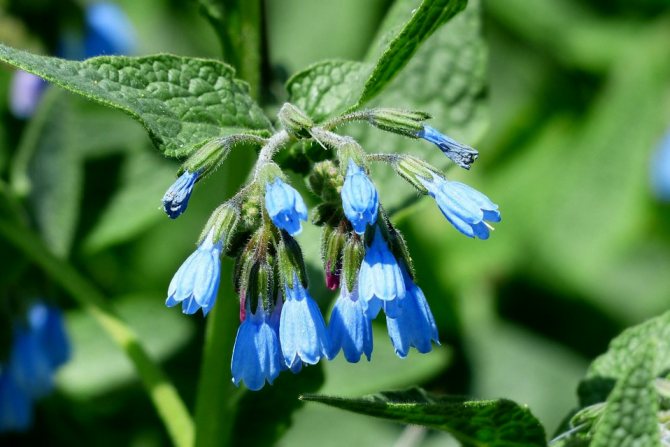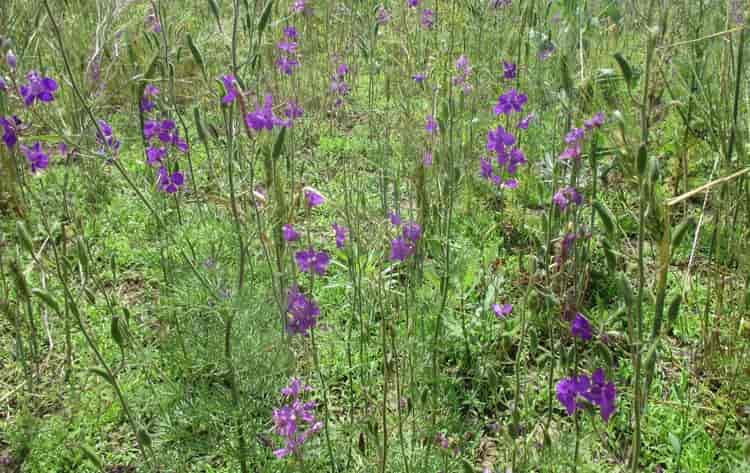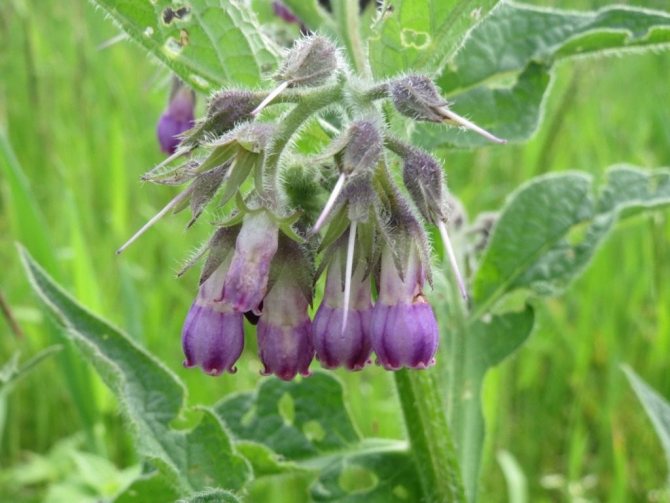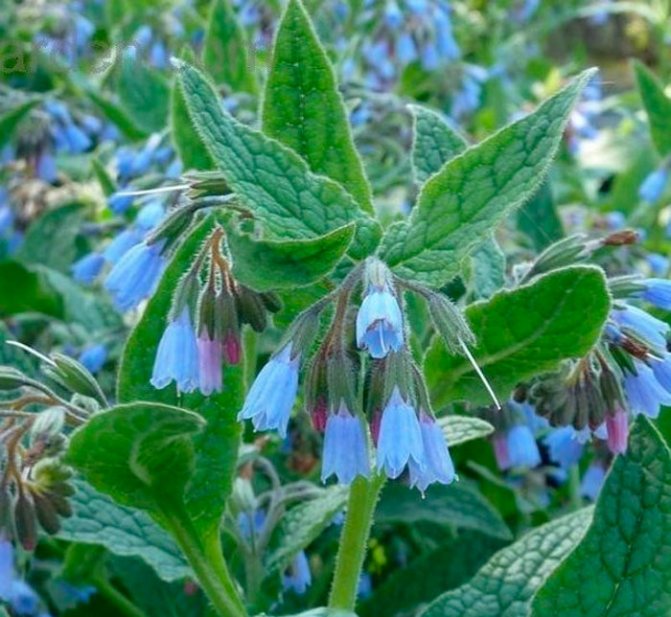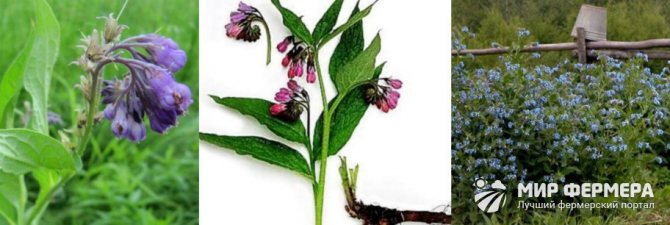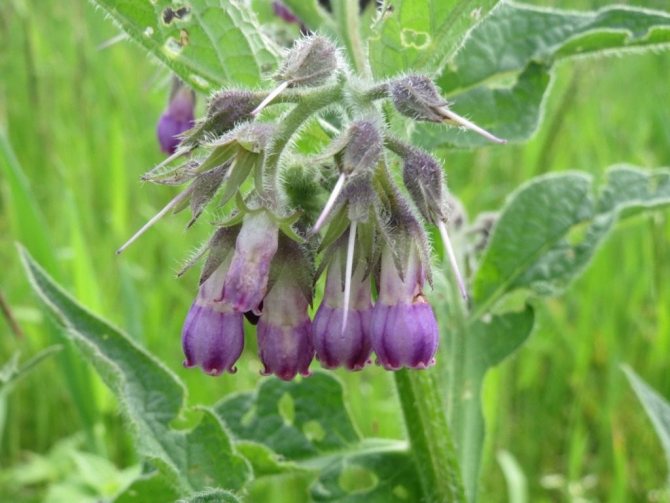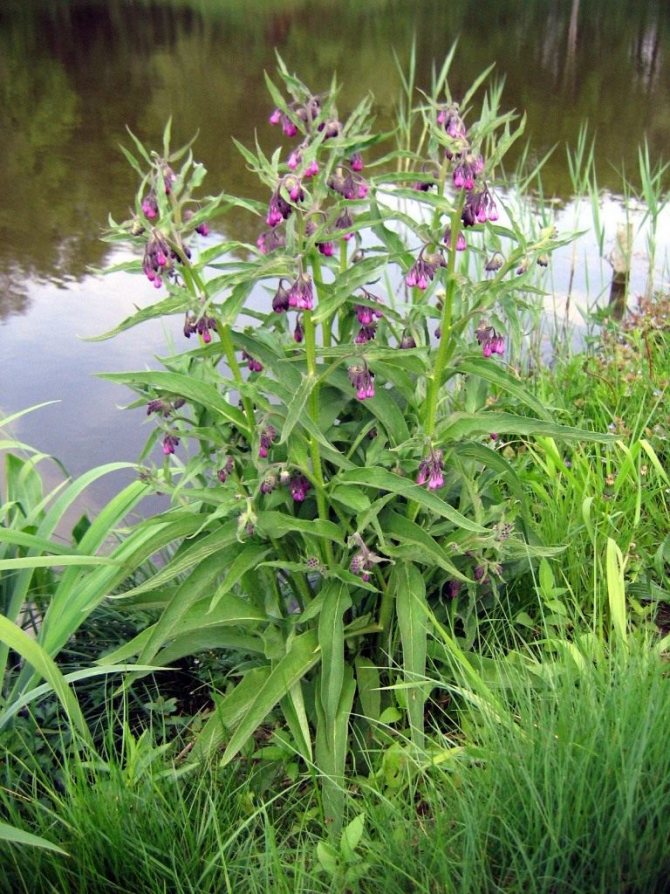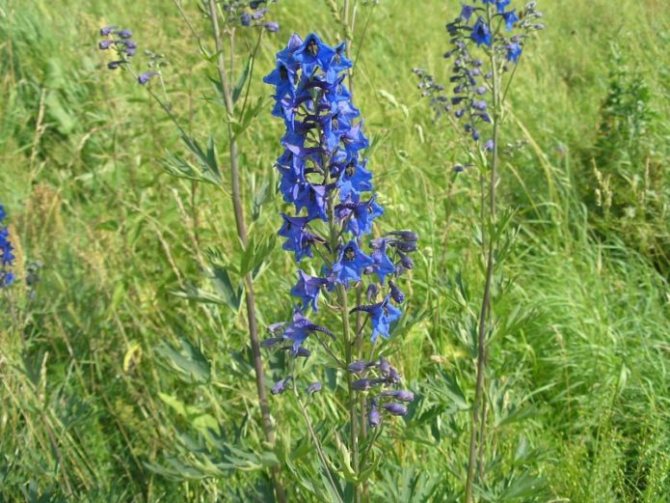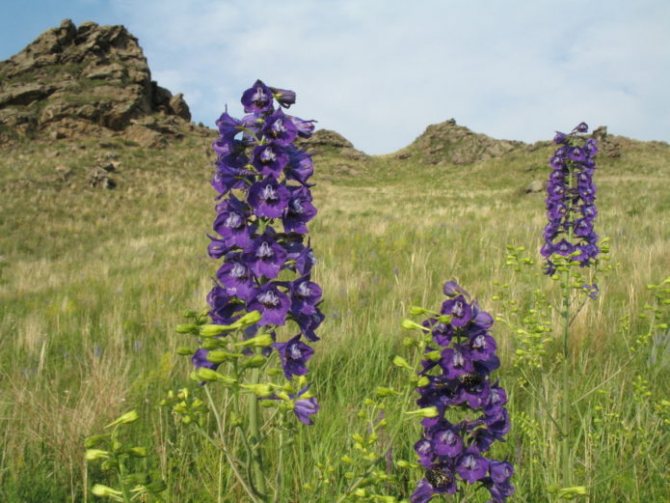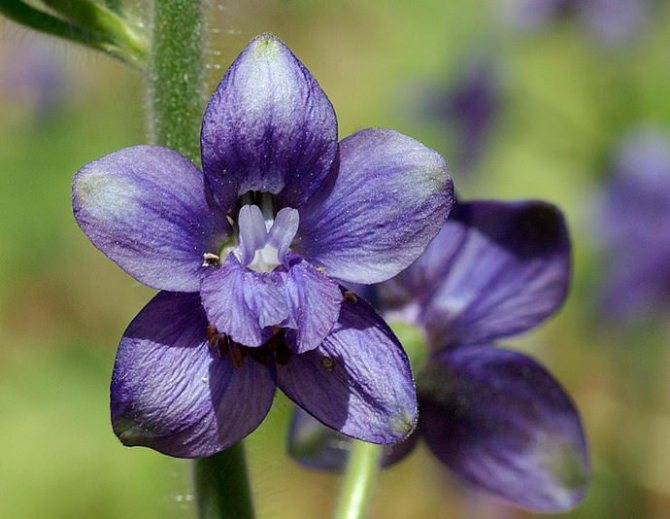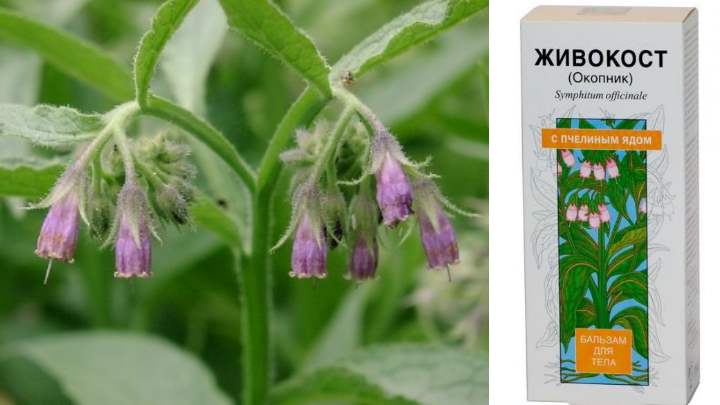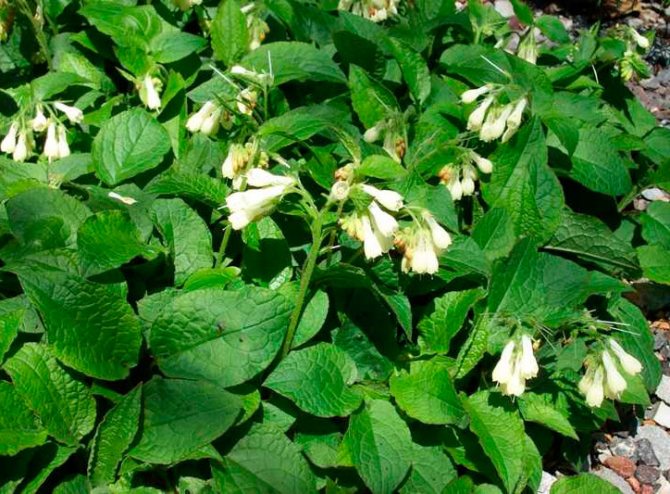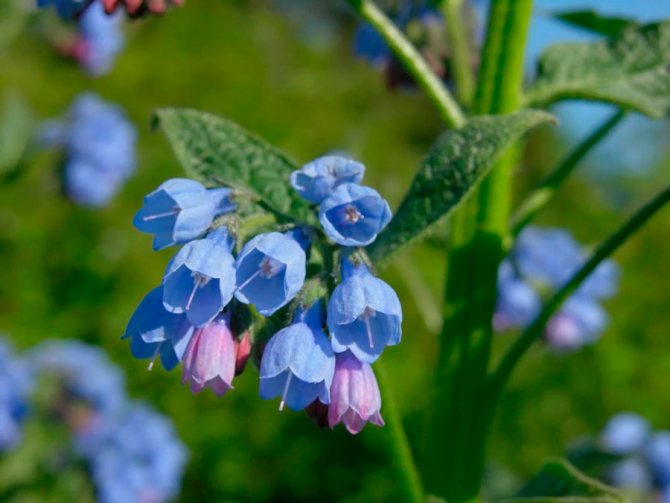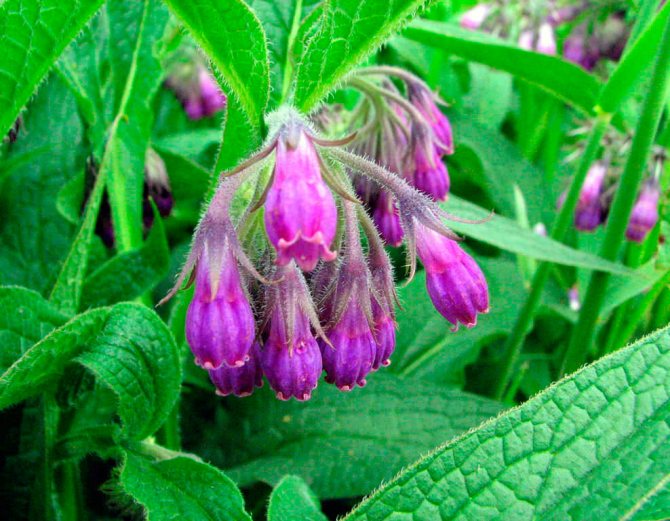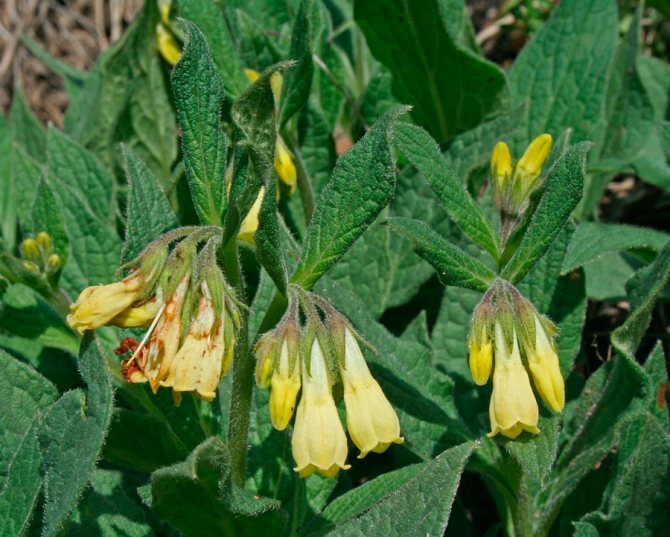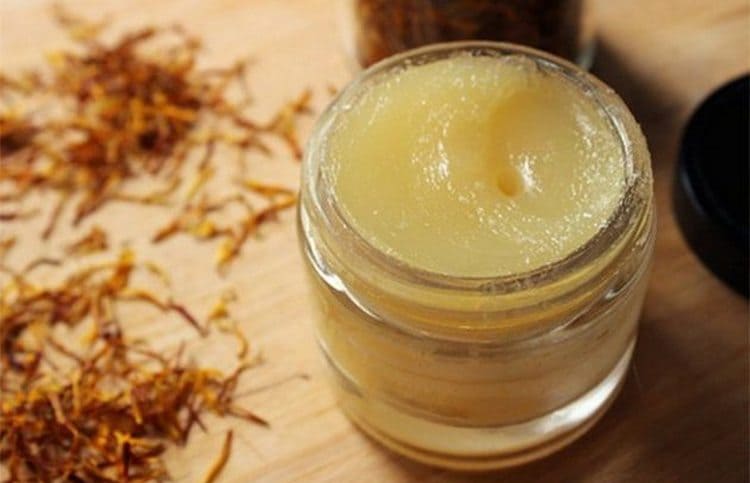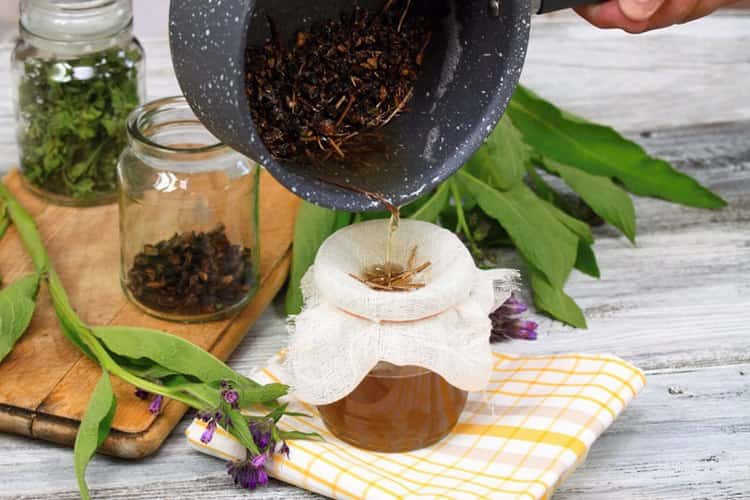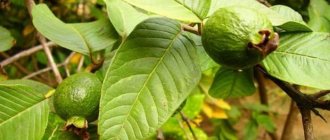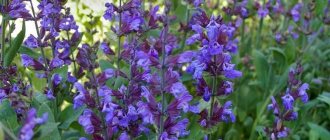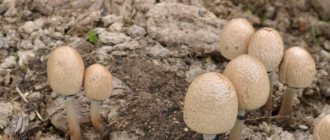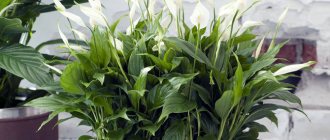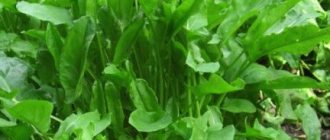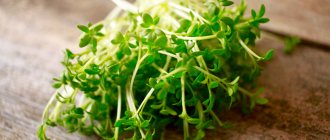Comfrey was mentioned as early as the 10th century in the famous medical poem of the French scientist and physician Odo iz Maine "On the Properties of Herbs":
“The root, which was excellently boiled in hot plums, mixed with honey, heals fractures and breaks ... If someone doubts that there is so much strength in the comfrey, let him cook the crushed roots with boiled meat ... Broken or crushed bones you will help with medicine. If, mixed with wine, they drink comfrey with pepper and honey, then both tears and wounds are treated with such an application. The bone that is broken holds the herb together with the ointment on the lard. "
Readers should be warned immediately that Comfrey treatment should be treated very carefully, since in addition to many substances useful for the body, it also contains poisonous substances.

Comfrey medicinal.
Comfrey (Symphytum) is a genus of perennial forest herbaceous plants of the Boraginaceae family, distributed throughout Europe from western Asia to the British Isles. The genus includes about 7 species.
So, in Latin, comfrey is called Symphytum - accrete, because the underground parts of the plant have long been used as a remedy for bone fractures.
In the literature in Russian, there are other plant names: bone breaker, vis-grass, greasy root, larkspur.
Where comfrey grows, photo and description.
The plant is classified as herbaceous. Consequently, it can be found in various places where the grassy cover of the earth predominates, for example:
- in the forest;
- in the swamp;
- on the edges;
- next to the river bank;
- in spacious glades.
Comfrey can often be found in the garden. It is very important for the plant that there is a favorable humid environment around it. Its flowers resemble a bell in their appearance, purple and blue, they are visible from afar, and the fruits can be associated with a small nut. The root is rather short. The breeding process is simple as the roots divide and the seeds spread nearby.
In botany, comfrey is usually called symphitum, which means "connection" or "fusion". Geographically, comfrey grows most of all on lands where a warm, mild and humid climate reigns: on the Crimea peninsula, in the Caucasus mountains, but there is a lot of it in Central Russia and Siberia. Also, one of the common names of comfrey is - "larkspur", "omentum", "pravokost", "greasy" or "fat" root, "brown chimney". The plant grows in Europe and Asia, as well as in Britain, there it is called "komfrey".
Application and preparation methods
Unfortunately, every second person is familiar with joint diseases. Of course, the degree of the disease is different for everyone, many trust only official medicine in the fight against their illness, someone combines treatment methods, and there are those who completely trust nature. There is no doubt that any intervention in the body must be justified and qualified. Therefore, a general recommendation for everyone before starting treatment is to consult a specialist.
Recipe 1.
Let's get acquainted with the main points that are important for the preparation of a drug that is effective in the treatment of joint diseases.
For infusion, take a three-year comfrey root.It is during this time that he accumulates the maximum amount of nutrients. The root will be black, it is not worth peeling it, the skin is also endowed with healing elements. Before use, it is thoroughly washed and grated or passed through a meat grinder. The resulting mixture is poured with moonshine and insisted for seven days, shaking daily several times a day. The resulting balm from 1 part of raw materials and 3 parts of moonshine is used to treat joints externally in the form of compresses. The composition is distributed in a thin layer on a cotton fabric and applied to the sore spot, wrapped up to keep the damaged area warm, it is best to do it at night. The use of the tincture eliminates inflammation, promotes bone tissue regeneration.
Recipe 2.
Alcohol tincture for internal use is prepared according to a different recipe. 100 grams of root is infused for two weeks in half a liter of alcohol. A single dose for the use of 30 drops diluted in half a glass of water. In addition to its direct purpose, the drug kills microbes and viruses in the body. The same tincture is used for grinding tissues. Daily use will allow you to forget about intervertebral hernia, reduce pain in the spine and lower back.
Recipe 3.
For external use with open lesions of the skin, the tincture is diluted with water to 15-20% of the alcohol content.
Used for the treatment of joints and root infusions prepared in water. It is being prepared as follows. 15 grams of chopped root is poured with a glass of boiling water and brewed for 8 hours. Then the water is poured into another container, and the root is poured with fresh boiling water (1 glass) and again insisted, only now for 10-15 minutes, after which the infusion is poured into the container where the previous one is located. This mixture has a powerful healing effect, and is indicated for use in the treatment of angina (rinsing), open wounds, ulcers (lotions, compresses, irrigation).
Recipe 4.
To combat such ailment as bone tuberculosis, an infusion of larkspur root, cooked in milk with the addition of an egg, 1 tablespoon of honey and 10 grams of goose (pork, lamb or badger) fat, is used. Compresses and lotions are made from such a composition, rubbing is also useful.
Recipe 5.
For oral administration, an infusion is prepared in milk for such a recipe. 10 grams of raw materials are mixed with 250 ml of milk and placed in the oven. Drink the ready-made composition one spoon at a time before meals. It is indicated for inflammatory processes in the kidneys and lungs.
Recipe 6.
In the pharmaceutical industry, various ointments and creams based on comfrey root are widespread. All of them are good enough and effective. Analogs can be made by yourself. To obtain an ointment, it is necessary to mix 10 grams of larkspur root (previously crushed) and 40 grams of animal fat, place the mixture in a water bath for half an hour, stirring constantly. Then, while still hot, the substance is passed through a fine sieve and cooled. The ointment is ready to use. Sore joints are rubbed with it. They are kept in the refrigerator. For the treatment of external tumors, a few drops of camphor oil are added to the substance.
Video addition:
Name:
the Latin name of the genus comes from the Greek word
"Symphyton" -
accrete. This property of comfrey has been known since the Middle Ages. Here is what Odo from Mena writes:
“The root, which was excellently boiled in hot plums,
Mixed with honey some more, heals fractures and breaks ...If someone doubts that there is so much strength in the comfrey,Let him cook the crushed roots with boiled meat ...Broken or crushed bones you will help with medicine.If comfrey and pepper and honey are mixed with wine,And tears and wounds are treated with such an application;The broken bone holds the herb together with the old ointment. ”
Description:
Of the 20-25 species of this genus, 17 grow on the territory of the former USSR.
Crimean comfrey
(Symphytum tauricum
Willd
.) grows in the European part of Russia, mainly in its southern half, as well as in the North Caucasus.
Comfrey cordate
(Symphytum cordatum
Waldst. et Kit. ex Willd
.) quite often found in the Carpathians, occasionally in Khmelnytsky, Ternopil, Zhytomyr regions; outside the former USSR - in Hungary and Romania. 3 Caucasian endemic species are confined to forest cenoses:
comfrey large-flowered
(S. grandiflorum DC),
comfrey roaming
(S. peregrinum
Ledeb
.) - both with pale yellow flowers,
comfrey Caucasian
(S. caucasicum
Bieb
.) Is a furry-fluffy plant with blue flowers. In the forests of the Black Sea and southern Podolia, it grows
oriental comfrey
(S. orientale
L
.) with whitish rims.
The medicinal properties of comfrey.
For medicinal purposes, it is customary to use only the roots. In the case of larkspur preparation, the roots of the plant should be used only after the flowers have subsided. Such roots should be well rinsed and dried for some time, since they contain a considerable amount of moisture. Comfrey leaves can be harvested even before the plant has faded. Just at this moment, a greater volume of allatonin accumulates in the comfrey roots, which is astringent in its structure and capable of unique medicinal properties.
This herb is used to make various medical and pharmaceutical products with medicinal effects. Many scientific researchers have studied the positive effects of comfrey on the joints. Their discoveries in this area of medicine helped to use the plant to treat various diseases. It should be noted that in modern medicine, comfrey extract is used even in the treatment of cancer.
Comfrey (Symphytum officinale)
Borage family, popular names: vis-grass, fat root, cucumber grass, bone breaker, larkspur... Perennial herbaceous wire-haired plant with a branched winged stem.
Leaves alternate, large, harsh, oblong-lanceolate, with a protruding network of veins below.
Flowers small, tubular-bell-shaped, purple-violet, collected in inflorescences-curls. There are five stamens, adherent to the corolla, pistil with an upper four-lobed ovary.
Fruit - large black shiny nuts, located four in the calyx of the flower.
Leaves when rubbed, they have a faint cucumber odor.
Roots black, whitish at break, their taste is sweetish, slimy, slightly astringent.


Comfrey medicinal.
Plant height 60 - 90 cm. Flowering time May - August. It is found almost throughout the European part of Russia, in the Caucasus, in Western Siberia, Central Asia. It grows among shrubs, in gardens, in damp places along the banks of rivers, streams and in flooded meadows. For medicinal purposes, the roots are used, which are harvested in spring or late autumn. Comfrey roots contain starch, sugar, many mucous substances, tannins, asparagine, alkaloids cinoglossin and laziocarpine, glyoxyldiurend allantoin, digallic acid and traces of essential oil. The plant, as already noted, is poisonous.
Joint treatment, comfrey recipe.
Directly for curing joints, there are various preparations containing the extract of this plant, for example:
You can also prepare a tincture at home by digging out comfrey roots in the fall, peeling and chopping them finely. Then all this should be poured with alcohol and in a dark, slightly cool place, let it brew. While the drink is infused, it must be shaken periodically. A week later, this tincture can be used to heal joints. The shelf life of the tincture is limited until the moment when saturated brown begins to predominate in the shade of its color. This color signals that the drink should not be consumed.But while the tincture is transparent, you need to wipe the joint with it.
Treatment of osteochondrosis with comfrey.
If a person suffers from osteochondrosis, then the tincture can be drunk. Take the tincture orally on an empty stomach in three stages:
- they use five days in a row, then ten days of rest, and then again ten days of use;
- at the second stage, another break is made, lasting twenty days, after which the tincture is used again within twenty days;
- the final stage, at which the period of taking the tincture is thirty days.
After a couple of months, the stages of treatment with the tincture can be repeated. This remedy can be used for swelling, joint damage, pain.
There are other ways to make a medicinal drink from comfrey. For example, the roots of a plant are taken, then peeled from excess husk, and then dried. Next, the dried roots are finely chopped and poured with one glass of hot boiled water. This drink must be boiled for at least ten minutes over low heat, and then carefully filtered with gauze. Then you need to let the medicinal drink brew, after which it will be ready for use. It is important to note that comfrey is a poisonous plant, if you exceed its amount in the body, it will cause bad consequences for the nervous system.
Side effects and contraindications.
Comfrey can have a significant impact on the regeneration of human bones, and this is its advantage over other herbal plants. In the event that the bone is destroyed into small particles, a tincture, decoction, ointment or balm with comfrey extract will easily help in the healing of injuries. However, do not get carried away with the use of comfrey, as it is only a medicinal plant. Since comfrey is a poisonous plant, toxicological dangerous consequences can occur in case of an overdose.
When treating joints, healthcare professionals advise using topical ointment. The recipe for this ointment is simple and not difficult to make at home. First, you need to grind the root component of the plant into powder. Then you need to add a small amount of lard in the ratio ¼. Store this ointment in the refrigerator. It is better to use the ointment before bedtime, when the joints will not be loaded with anything. For infusion, you can use a glass of boiling water, previously in a glass, placing one small spoonful of the crushed root, and then let it brew. In medicine, this plant is used in the prevention of more than a hundred diseases. In addition to its medicinal properties, comfrey has a tonic effect, which plays an important role for any person. The result of using the tincture can be improved by adding honey to the decoction.
When inflammatory changes appear, joint disease is usually diagnosed. If you competently approach the issue of treating such symptoms, and do not waste time, you can cure such manifestations in time without losing motor functions.
Collection of plants, composition, benefits. Recommended recipes
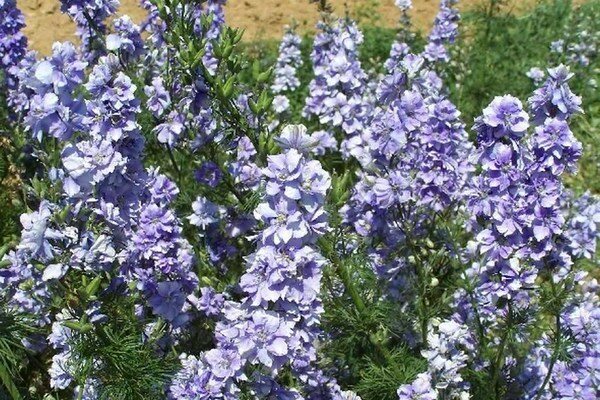

Larkspur is grown not only in the wild, but also in the territory of summer cottages for medicinal purposes and simply as an ornamental plant. According to the requirements, the plant is completely unpretentious, any soil composition is suitable for growing. There is of course a preference for a more calcareous composition, but this is not important.
The amount of moisture does not matter, since in the wild, the plant is habitually tolerant of both strong moisture and dry, long periods. Pests and diseases generally bypass this plant, due to its toxicity. Frosts, even the most severe, are not terrible for larkspur.
How can you multiply this herb? Very simple, by seeds. It is necessary to plant in the spring and only those seeds that were harvested in the fall of last season. It is advisable to moisten the soil before planting.When sowing before winter, there is no need to moisten. At the same time, the germination rate is higher in percentage terms. If a perennial variety of larkspur was chosen for planting in the garden, then it reproduces independently, by ejecting seed material at the place of growth.
For the treatment direction, the material must be collected at different periods of the season. All ground parts of the plant must be collected when the plant is still actively blooming. These are flowers and leaves, around June-end of August. The rhizome is harvested only in late autumn, after a complete cessation of the active development of the grass.
Dry recommended only in a dark room, but well ventilated. Spread a thin layer of raw materials on the shelves. The temperature should be medium, drying in special devices is not recommended, only natural drying. Storage must be carried out in paper or cloth containers.
During the collection, work with the plant, it is advisable to use rubber gloves, since the plant still has some of the toxicity, very carefully, perhaps you have hidden reactions and the plant is able to activate them. After working with the plant, strictly treat your hands or simply wash with soap. When there are wounds or other damage to the skin on the hands, it is better to postpone the collection, since the plant sap easily enters the body through the damaged areas.
The concentration of the poison in the fresh raw material is higher than in the dried state. It is strictly forbidden to taste the plant for its taste. A direct path to poisoning. When larkspur is grown in a garden plot, all precautions must be taken, since not only you, but also your loved ones and pets, who are not informed about the dangers of this herb, can come into contact with the plant.
Only in appearance the plant is harmless, in some varieties the effect of the poison can be compared in severity with the poison of the famous snake curara.
In medieval times, healers also used the properties of the plant. You can find a guide to the preparation of various preparations used in the occurrence of lice, when there is a problem with scabies, scab. In the English literature, you can find a recipe for the treatment of a scorpion bite, which in those days was generally considered a hopeless disease. This recipe specifies the use of larkspur roots only.
Already in our time, during the Second World War, medicine was used as a remedy for parasites in the body. Nowadays, gardeners use powders as an insecticide against pests. It is also possible to use it in the veterinary direction, for example, when helminths are found in sheep. Of course, all this is done in the required dosage and under the supervision of specialists.
Dyeing pigments isolated from plant flowers were widely used for dyeing fabrics. The plant itself is a honey plant, but the collected honey is not suitable for consumption. May cause intoxication of the bee's body. Honey, obtained from larkspur pollen, is popularly called drunk, it is not used inside.
With improper handling or use of drugs, poisoning. The first symptomatics:
- coma;
- oppressed breathing, intermittent;
- cardiovascular rhythm disturbance;
- severe cramp.
What to do??? The very first aid is to rinse the stomach, drink any laxative, adsorbent, cardiotonic, urgently provide free airway, and most importantly, urgently seek help from a specialist, in extreme cases, an ambulance.
Description
Before you start collecting these herbs on your own, you should carefully study the photo of the medicinal comfrey, so as not to harm yourself later.The fact is that it is very similar to the Caucasian comfrey, which does not carry any medicinal properties at all. They have only one difference - this is the shade of the flowers. In the medicinal species we need, they are pinkish-purple, but in the Caucasian comfrey they are blue-blue.
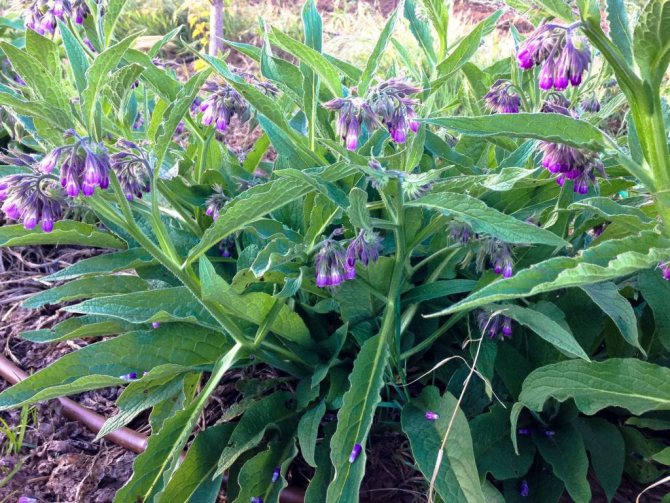

Now let's directly talk about the photo and description of the medicinal comfrey. By itself, this is a herb belonging to perennials from the Burachnikov family. It has a branched stem that can reach a maximum of a meter in length. At the very bottom, the grass has the shape of a tetrahedron, which is decorated with large oblong leaves about 15 cm long, and only about 5 wide. All the lower foliage has long winged petioles, but the upper leaves are sessile. All leaves and stems must have hard hairs - this is a distinctive feature.
The flowers have a tubular-bell-shaped appearance during the growing season, but in adult form they take the form of small panicles. They open in late May or early June and can have different shades - purple, lilac, purple.
Comfrey: botanical reference
Comfrey officinalis is a representative of the Borage family. The plant is found in the vast Russian expanses - in the steppes, forests, in the foothills of the Caucasus and the Carpathians. The spreading bush reaches a height of 1 meter, the leaves and stem of the comfrey are densely covered with fine hairs, and the bell-shaped flowers of lilac tones are collected in bouquets. Comfrey blooms from late spring to mid-autumn.
For the preparation of medicinal potions that help in the treatment of a number of diseases, comfrey roots are used (the rhizome reaches a length of up to 40 cm, the shoots and fibrous roots have healing power).
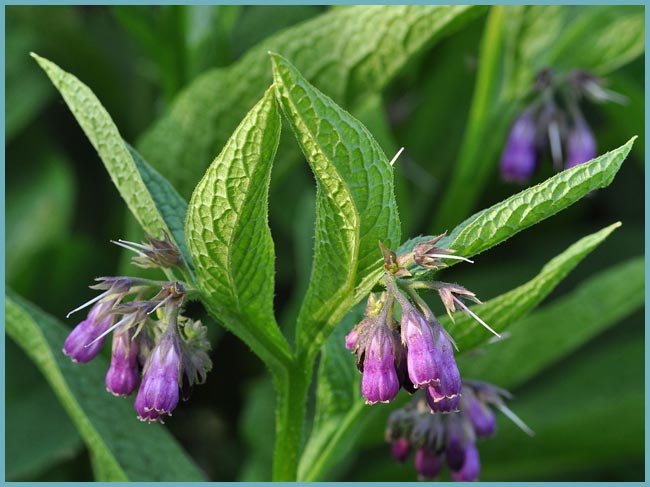

Comfrey bloom
Procurement period
In order for comfrey grass to have useful properties, it is very important to properly prepare it. It is worth remembering that flowers are not used in folk medicine, since only roots and leaves are taken. Collecting a plant is required at different times:
- The roots should be dug out in early spring, before the leaves begin to bloom. In addition, harvesting can also be done in the fall, after the end of the flowering period. The roots will need to be washed, cut into small pieces and dried.
- The collection of leaves takes place exclusively during the flowering period.
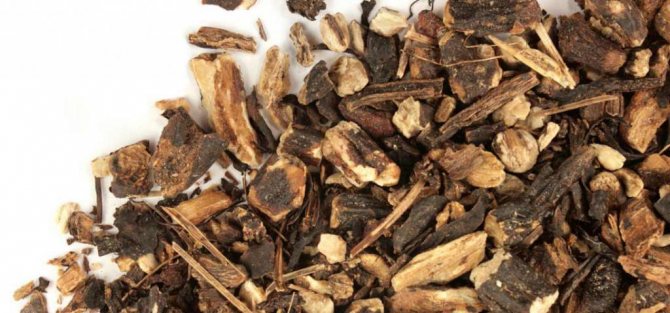

Comfrey harvesting: how to do it right
For the preparation of medicinal products from comfrey roots, it is required to properly harvest herbal raw materials. It is allowed to start digging out rhizomes in the autumn, for this it is worth waiting for the leaves to fall. The rhizome can hibernate in the ground, then digging is started in the spring after the soil thaws.
Rhizomes dig in carefully, trying not to damage the lobe of the roots. The excavated parts are thoroughly washed with running water, dried with a napkin and cut into lengths up to 5 cm. The cut comfrey rhizomes are dried away from direct sunlight, periodically turning the pieces over. After three days, the rhizome segments dry out completely. Raw materials are stored in linen bags in a suspended state.
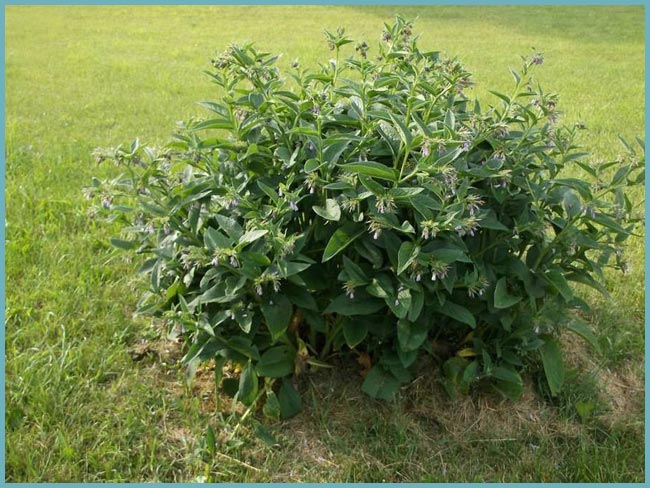

Comfrey needs to be dried in the shade
For the preparation of dosage forms, comfrey flowers are often used, which are harvested during the period of mass flowering. The collected raw materials are laid out for drying on pallets. Store in the shade in a windy place. Dry parts of the grass are stored for no longer than 2 years.
Growing area
We have provided a description and photo of the plant. Where does comfrey grow? In total, there are about 17 species of this plant in Russia, but we will focus on the medicinal one. It can be mainly found in Western Asia and Europe, and to be more precise, in Siberia, the Carpathians, on the foothills of the Caucasus, in the Crimea. If you are wondering where the comfrey grass grows, the photos of which were presented above, then you should choose wet places.It can be found in broad-leaved forests, near various water bodies, on the outskirts of swamps, meadows and glades with moist soil, in ravines. In some cases, it can be safely grown even in vegetable gardens and orchards, if watered abundantly.
Contraindications
In no case should you use comfrey if you have the following contraindications:
- pregnancy at any time, as well as while feeding the baby;
- it is also not recommended to use it on children - the minimum threshold is set at 7 years, although it is still better not to apply it until the age of majority;
- if you have a hypersensitivity or allergic reaction to the grass itself.
But in any case, comfrey can be used only after consulting a doctor in minimal quantities so as not to harm health. An overdose is very dangerous to them, since it can cause disruption in a number of internal body systems.
Beneficial features
Now that it has been found out where the comfrey plant grows, and the photo with the description also made it clear what kind of plant it is, let's move on to its useful properties. In fact, the spectrum of its application is quite diverse, since at the same time it can have an anti-inflammatory and regenerating effect. The whole plant is filled with useful substances, although, as mentioned earlier, the bulk is stored in the root.
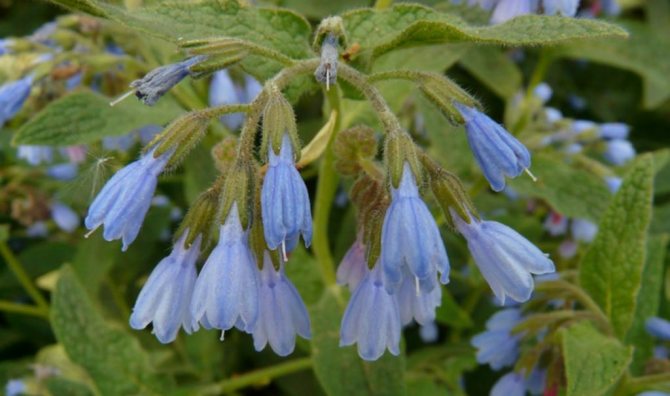

The main useful properties of comfrey include:
- the ability to slow down and even quickly stop external and internal bleeding;
- ensuring accelerated fusion of bone tissue in case of dislocations and fractures;
- improved appetite;
- reducing the painfulness of symptoms that appear in diseases of the colon and hemorrhoids;
- lowering blood sugar levels;
- improvement of the respiratory system;
- anti-inflammatory and antimicrobial effect;
- reduction of pain after injury;
- stimulation of accelerated regeneration of body cells;
- strengthening the intestinal muscles and solving the problem of diarrhea;
- providing a therapeutic effect on the skin for allergies, skin diseases or injuries such as burns.


Looking at the photo of the comfrey plant, it is really difficult to believe that this plant has a huge number of beneficial properties. It is quite versatile, and therefore it is used very often in the form of various tinctures, lotions, compresses. In addition, it is part of a number of medicines that are used in official medicine.
Botanical features and procurement of raw materials
In the form of an ambulance, medicinal comfrey moved to us from the distant regions of Central Asia, the Caucasus, Western Siberia, China and settled in the forests and steppes of the European part of Russia. It is impossible not to notice it. Rising almost 2.5 meters above the ground, it greets the world with its oblong-ovoid, dissected leaves. It looks out from the thickets of bushes, then from the slopes framing streams and rivulets, then it is important to spread out on wet meadows.
A plant from the Buttercup family of the genus Delphinium (lat. Delphinium) blooms in May – June, but accumulates healing power in a brown root with white crumbling pulp by late autumn. It is he who is famous for his ability to heal fractures, help bone grow together, restore damaged ligaments, and relieve pain.
Collected spur for medicinal raw materials at the age of three years, when the roots turn black. Inside is white crumbling pulp that secretes mucus. In the old days, they knew that this was done on the New Moon in November.
Comfrey in the old days was an ordinary garden culture. The stems were peeled and used in pickles, soups, and seasonings. During religious fasts, he gave the body protein, essential vitamins and minerals.
Composition and healing properties
Like no other plant, the larkspur contains a lot of allantoin or glyoxylic acid diureide.It is rich in alkaloids, tannins, flavonoids, plant mucus (water-soluble polysaccharide), vitamin B12.
It contains plant acids - phenolcarboxylic:
- oxycinnamic;
- lithosperm;
- neochlorogenic;
- chlorogenic;
- rosemary;
- coffee shop.
The healing plant contains a set of tannins, proteins and triterpenes, phytosterols necessary for the human body (stigmasterol, β-sitosterol, isobauerenol in the form of a glycoside, triterpene alcohol).
The list of useful substances is complemented by iridoids and inulin, choline and starch, and coumarins, monoterpene glycosides and traces of essential oil. Leaves and stems have organic calcareous compounds that can help solve osteoporosis problems. The people respected the larkspur for its amazing properties to heal various diseases. Its most important purpose is to restore damaged bones. In addition, they were treated:
- bruises, dislocations and sprains;
- joint pain and amputation stump;
- inflammation of the periosteum;
- osteochondrosis and phlebitis;
- arthrosis and arthritis;
- sciatica and gout;
- wounds and thrombophlebitis;
- purulent ulcers, abscesses and boils;
- frostbite and burns;
- chronic bronchitis and pulmonary tuberculosis and sore throat;
- osteomyelitis, stomatitis, periodontal disease and diathesis;
- mastitis and rheumatism;
- stomach and intestinal ulcers;
- enterocolitis and chronic colitis,
- internal bleeding and nose;
- dysentery and diarrhea;
- kidney disease and hemorrhoids;
- fungal vaginitis and skin fungus.
Perennial helps lower blood pressure. Women use decoctions as a contraceptive. Comfrey gives the doomed a chance to defeat malignant tumors.
We repeat that the larkspur is a very poisonous plant. Alkaloids - consolidin and cinoglossin in large doses cause paralysis of the central nervous system.
So, with its analgesic, anti-inflammatory and regenerating effects, medicinal herb works miracles of healing and gives health.
Zhivokost in traditional medicine recipes
The health fighter with its flowers, leaves and roots is used in decoctions, infusions, tinctures and ointments.
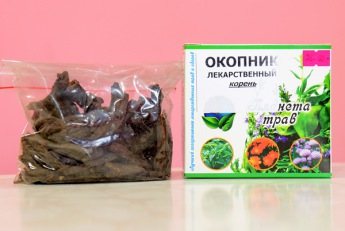

1. An old recipe of Transcarpathian herbalists for fractures, back pain, osteochondrosis. The rhizome is cleaned and pounded in a mortar (you can use a meat grinder). Poured 1: 3 only with moonshine (not vodka or alcohol). The container is removed in a dark place for seven days (shake 6 times daily). The tincture is effective as long as it is light, as it turns brown, you need to prepare a new portion. It is used for compresses and rubbing.
2. Recipes of the Siberian medicine man for old salt deposits. This nuclear weapon is used to lift people twisted by years of pain and suffering. The secret is simple. Peeled and crushed roots (1 part) are mixed with lard of lard (2 parts). The ointment is rubbed into the places of salt deposits, with thrombophlebitis, helps with boils and abscesses, burns.
3. Roots with honey will drive salts from everywhere, and whoever needs it, and tuberculosis will be cured. Mix them in crushed form 1: 4 with honey. For two weeks, take the mixture a teaspoon before meals for half an hour. Break for 2 weeks and be treated again.
4. The washed roots are wrapped in clean paper and placed in the basement or lower compartment of the refrigerator. Take it out and clean it. In the morning, cut off a piece of 1 cm, chew thoroughly and swallow the chaff to taste, like hay. Do this half an hour before breakfast. Further according to the scheme:
- 5 days of treatment - 10 days off;
- 10 days of treatment - 20 days off;
- 20 days of treatment - 30 break.
If the disease persists, repeat the course in the same sequence.
5. With diabetic foot. People with diabetes can endure unbearable pain from cracks and wounds in their feet. Eventually, the disease can develop into gangrene. To prevent this from happening, a healing infusion is being prepared in the Caucasus.
6.Dry crushed root (2 teaspoons) is poured with cold water - boiled and cooled (300 ml) for eight hours. Then the water is poured into a clean container, and the root is poured with boiling water (200 ml) and allowed to cool. The first infusion is added to the second and again kept for a day. The remedy is taken every 2 hours all day from 8.00 am to 20.00 pm, so until the healing of wounds and ulcers.
7. Ointment "Zhivokostovaya" for all bone diseases. One root is washed, but not peeled and crushed. Mixed with internal chicken or rabbit fat (1 teaspoon) and milk (3 tablespoons). All are heated to a hot tolerable temperature. Form cakes and apply to sore spots, fixing and insulating the compress for the night. Do until recovery.
Tips and contraindications
After grinding, the root immediately turns brown, secreting mucus, which quickly thickens. Therefore, everything is done quickly and accurately when mixed with other components. Funds with this raw material are not boiled.
It is necessary to use drugs with a poisonous plant with extreme caution. For hypotonic patients before comfrey treatment, it is recommended to consult a therapist, as it lowers blood pressure. You can not take raw materials for pregnant women and children. And also if there is an individual intolerance.
Even before the great Avicenna, mankind turned to plants for help in diseases. Zhivokost is one of them. Today, this amazing medicinal herb has been undeservedly forgotten, and may disappear from our Earth altogether. But folk wisdom raises layers of age-old traditions, telling us about the life-giving abilities of the surrounding green world.
Plant danger
Comfrey is one of the poisonous plants, so you definitely can't eat it. Even when used as a lotion, be sure to take this fact into account and use a small amount, because otherwise you can get burns, problems with the liver and the central nervous system.
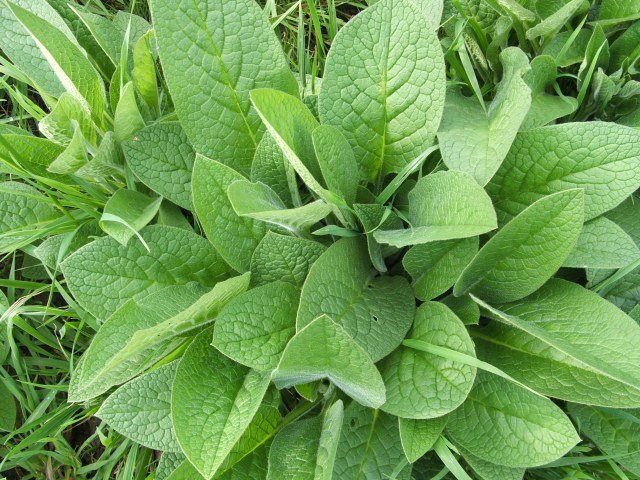

Compositions for use must be made on a fat basis, so you don't even need to think about applying a fresh leaf to the wound. Ointments are also not rubbed directly into the damaged area, but only rubbed a little near the wound. In this regard, decoction compresses are indeed the safest way to use them, since they can be applied to bruises.
The use of herbs in pharmaceuticals
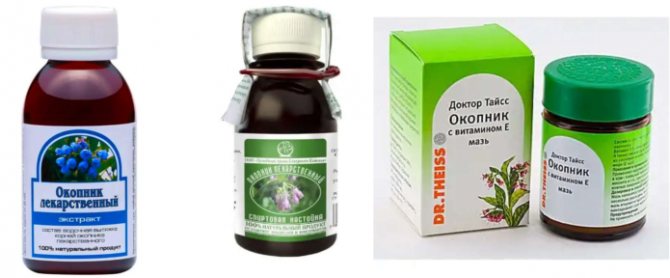

Pharmacy outlets sell different dosage forms based on comfrey
In pharmacies, you can purchase various forms based on comfrey: dry herbal raw materials, alcohol tincture, elixir, ointments (pure and with the inclusion of other useful components).
The muscle relaxants contained in this plant are used in traditional medicine for the production of the following medicines:
- Condelfin - made of tall larkspur;
- Delsemin - produced from retina larkspur;
- Elatin is an alkaloid obtained from the extract of high larkspur;
- Melliktin - made from a variety of comfrey, as in the previous version.
All of these medications are aimed at relaxing the muscles that are blocked by nerve endings (Parkinson's disease, multiple sclerosis, spastic paralysis).
Application
If you look closely at the photo of comfrey grass, it is difficult to believe that this, at first glance, weed is one of the most famous plants that are used in folk medicine. However, in fact, it is filled with a huge amount of useful substances, which are mostly contained in the root, although in some cases the leaves are also used.


Comfrey is now widely used in the treatment of joint diseases. The plant's life-giving properties have been seen in the treatment of osteoporosis, osteochondrosis, arthritis, as well as in dislocations or bone fractures. However, quite often it is also used for diseases of the thyroid gland and gout.
Botanical description and photo
Larkspur field (lat. Delphinium consolida) is an annual herb, a representative of the genus honeysuckle and the buttercup family. It is a field weed.
It lives throughout the Eurasian continent, in particular in a significant part of the countries of the former Soviet Union - in Russia (in Western Siberia, in Altai), in Ukraine, in the Caucasus, in Asia Minor. Prefers wet meadows, marshlands, river banks. It settles along the roads in the forest belt.
The herb is used in folk medicine, ornamental gardening. It is a honey plant, but honey from it is not suitable for consumption. Also used as an insecticide. The infusion of petals can be used as a blue dye for natural fabrics.
The Buttercup family also includes: black cohosh, hellebore, prince, aquilegia, swimsuit, anemone, lumbago and basil.


Stems and leaves
The stem of the plant reaches 25 to 70 cm in height. It is erect, well branched. It can be glabrous or slightly pubescent with short, recumbent hairs.
Larkspur leaves are alternate, several times dissected, covered over the entire surface with white hairs. In length they reach 3-4 cm. Basal leaves grow on petioles, upper leaves without petioles, sessile.
Flowers and fruits
Larkspur bloom begins in early summer. Ends in the last summer month. The flowers appear irregular in shape and are 1.5-2 cm in diameter. They are combined into rare brushes. They have a thin straight spur.
They can be painted in purple, pink, white. After flowering, fruits are formed in the form of single, unopened leaflets 1-1.5 cm long, which contain dark ovoid seeds.


Important! All organs of larkspur contain alkaloids that are poisonous to humans. Most of them are contained in seeds. Therefore, they must be handled with extreme caution.
Comfrey root tincture
Comfrey tincture is easy enough to make at home. To do this, you just need to take one tablespoon of pre-chopped root, and then pour a glass of boiling water over it. Next, the mixture must be covered and left to infuse for about eight hours. After that, the entire composition is filtered, and the root is removed. However, this is not the whole brewing procedure. After that, the swollen root must be refilled with a glass of hot water, but now it must be left to brew for about five and a half hours. In total, after this, you should get two different strained broths. They must be mixed with each other in equal quantities and only then used for their intended purpose.


In addition, you can independently prepare an alcohol version of the tincture. To do this, you need to put about half a glass of crushed roots in a jar, and then pour them with half a liter of vodka. The mixture will need to be left in a dark place with a low temperature for ten days. After that, everything is filtered. As a standard, it is recommended to drink this remedy 3 times a day, 20 drops before meals. The infusion must be diluted with a small amount of pure water before use.
In addition to direct ingestion, comfrey infusions can be used for compresses, rinses and baths at will.
Medical Uses of Larkspur
Larkspur found its application in traditional medicine... The drug Melliktin, obtained from various types of comfrey, is used for high muscle tone, and the drug Delsemin is used in surgery to turn off spontaneous breathing and relax the muscles.
In pharmacy chains, medicinal ointment and restorative balm are sold. Indications for the use of larkspur ointment are:
- radiculitis;
- neuralgia;
- rheumatic pain;
- sciatica;
- myalgia;
- osteochondrosis;
- arthritis;
- intervertebral hernia;
- sports or household injuries: sprain, closed fracture, contusion;
- dry and cracked skin;
- long non-healing wounds;
- trophic ulcers.
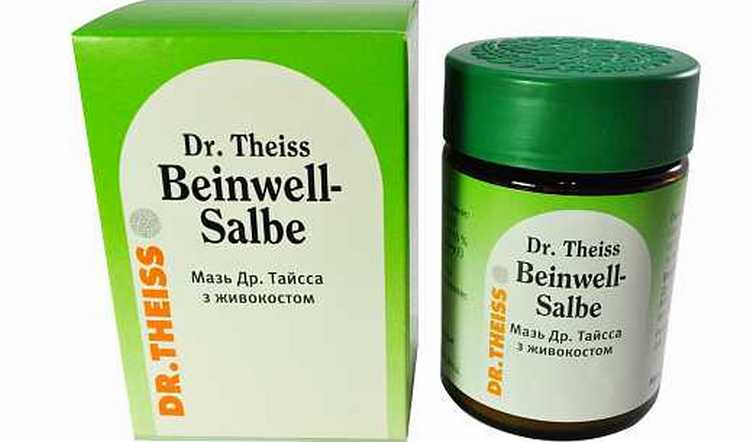

Instructions for using the ointment Larkspur recommends applying the ointment in a thick layer and rubbing thoroughly into the skin. This should be done 2-3 times a day. A bandage with ointment can be applied overnight. The duration of the course depends on the type and form of the disease, and it will be better if a doctor prescribes it, but in any case, it should not exceed 1-1.5 months during the year.
Testimonials
Judging by the reviews, medicinal comfrey is really good at helping with various joint problems. That is why it has been actively used in folk medicine for several centuries. In general, now the plant itself is rarely used, since basically ready-made tincture is bought, which is often prescribed for the prevention of joint diseases or already for their treatment. Such a drug allows you to simultaneously exert several types of effects: it prevents the development of inflammation, has an antimicrobial effect, and also heals wounds. Of course, it should be borne in mind that it will not be possible to provide serious treatment with its help, but it can help alleviate the symptoms of injuries, both light and moderate in severity, such as dislocations, bruises and sprains.
Why is larkspur useful?


Larkspur seeds have bactericidal properties
The rich biochemical composition determines a wide range of medicinal properties of the field larkspur:
- expectorant;
- anti-inflammatory;
- pain reliever;
- antiparasitic;
- diuretic;
- insecticidal;
- hemostatic;
- astringent;
- wound healing.
Comfrey is used to treat a number of diseases:
- oncology;
- epilepsy;
- asthma;
- gastritis and stomach ulcers;
- physical exhaustion;
- eye diseases;
- sclerosis;
- skin diseases and all sorts of violations of the integrity of the epidermis (burns, boils, abscesses);
- disturbances in the functioning of the digestive system;
- jaundice.
Larkspur tea is drunk as a diuretic. And for problems with the genitourinary system, pancreas, lungs and gastrointestinal tract, take decoctions. With the help of infusions, it is possible to normalize vision and stabilize the work of the nervous system. Compresses are made from decoctions and infusions for fractures and festering wounds. Ointments help with rheumatic and other pains. Comfrey preparations relieve inflammation in the oral cavity well. A powder is made from the seeds, which helps to expel worms from the body.
Depending on the disease, the plant can be applied both internally and externally.
Available contraindications
Despite the many useful properties, larkspur has contraindications. These include:
- pregnancy and breastfeeding;
- childhood;
- hypotension;
- myasthenia gravis;
- allergy to individual components in the composition.
In case of overdose, side effects are possible in the form of nausea, dizziness, vomiting and muscle cramps. In such a situation, it is required to urgently flush the stomach and deliver the poisoned person to the hospital.
Although larkspur and a low-toxic plant, after collecting it, you need to wash your hands with soap and water. It is important not to allow pollen to get on the mucous membranes.
Description of medicinal comfrey


Comfrey is one of the famous representatives of herbaceous plants that can be found in Europe and Western Asia.
In our country, this plant is represented everywhere in the European part, in the south of Western Siberia, in the Crimea and the Caucasus.
The favorite habitats of this plant are deciduous forests, meadows, wet meadows, water bodies, as well as forest ravines and the outskirts of swamps.
It often grows near houses, in gardens and vegetable gardens, as well as in places where waste is stored, where high humidity prevails.
Comfrey officinalis is a classic perennial, representing the borage family. As it grows, it forms a branched stem that can grow up to 1 m.At the bottom, the plant has a tetrahedral shape, it is decorated with large oblong leaves, 10-15 cm long and 5 cm wide. The foliage located in the lower part of the stem has long winged petioles, the leaves in the upper part are sessile. A characteristic feature of comfrey leaves and stems is the presence of hard hairs.
An adult plant has a short black root with a thickening. At the cut point, the rhizome is white, the pulp has a sweetish astringent taste.
During the growing season, small tubular-bell-shaped flowers are formed. They grow as panicles at the ends of the stem and branches. By themselves, they resemble a one-sided curl, which remains closed until flowering. When this time comes, the flowers begin to transform: at this moment they can acquire a purple, lilac or violet hue. Flowers usually begin to open between May and June.
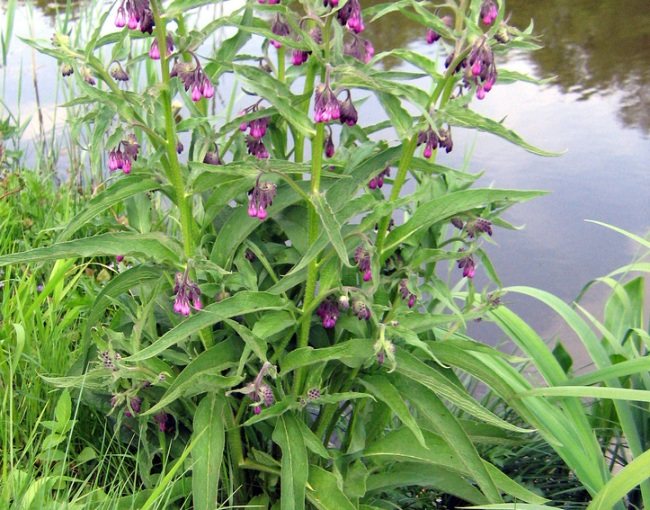

At the stage of seed ripening, four smooth black nuts are formed, reaching a length of 4-5 mm. They usually ripen in July-September. Each adult comfrey can produce 800-1000 seeds per season. For reproduction, you can use seeds or divide the rhizome.
Comfrey grass.
The Latin name for plants of the genus comfrey comes from the Greek word symphyein - "fused" and indicates the ability of products containing comfrey to accelerate the healing of bone fractures.
Description of herb comfrey
Comfrey medicinal - (popular names for Adam's herb, borage, whitethroat, viz-herb, vet-herb, lop-eared, harboring, larkspur, group, larkspur, larkspur, pravokist, zhalynik, vein, fatty root, greasy root, omentum, apothecary omentum , bone breaker, paint pink, boat rider, millet volot, shot, sverbiguz, break down, ox tongue (Ukraine) - a perennial herb with a short black rhizome, from which long, thick, branched roots, almost black on the outside and whitish at the break, extend. numerous, oblong-ovate or oblong, long-pointed, appressed-bristly from above, and from below almost glabrous or grayish with bristly hairs.The lower ones are large, with long narrow petioles, the upper ones are sessile.
Shoots are powerful, 50-100 cm tall, branched, hooked-spinous along the edges. Flowers in curls forming a paniculate inflorescence, purple, later blue with a white edge. The calyx is 2 times shorter than the corolla, deeply five-part with lanceolate pointed lobes, the corolla is up to 18 mm long, tubular-bell-shaped, shallowly five-lobed, in the pharynx with 5 lanceolate-subulate scales; 5 stamens, shorter than the corolla; pistil 1 with a long threadlike column and a small stigma. The fruit is dry, decaying when ripe into 4 ovate-triangular, black, shiny nuts 5 mm long.
Blooms in May-August.
Distributed in the forest and steppe zones of the European part of Russia (except for the Far North), in the Caucasus, in Siberia, in East Kazakhstan, in the Ukraine, in Belarus, in Moldova. On the territory of the former USSR, there are 10 species. All plants are poisonous. It grows in damp meadows, along the banks of rivers and streams, lakes, near ditches, streams, in bushes, ravines, gullies. Comfrey roots are a medicinal raw material.
Application and medicinal properties
Comfrey has a long history of medical use.
The use of medicinal comfrey
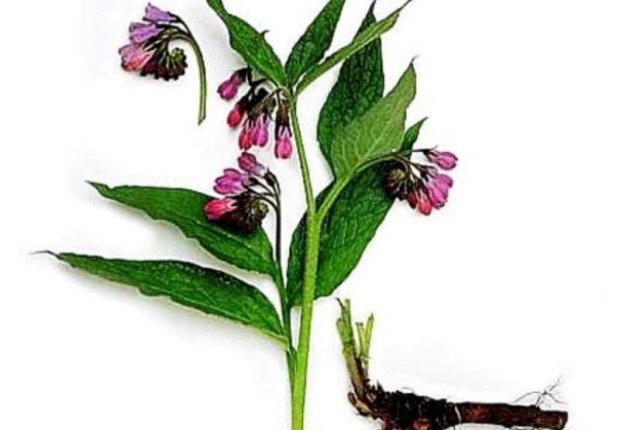

For a long time, folk healers were able to get acquainted with the beneficial properties of comfrey root. Preparations from this raw material are very effective in the treatment of bone fractures, wounds, kidney diseases, cough, bronchitis, pulmonary tuberculosis. They can also help with inflammation of the stomach and intestines, diarrhea, restore metabolism. As an external agent, they are used in the fight against diseases such as:
For internal consumption, a comfrey-based product is used in cases where it is necessary to achieve the fastest healing of bones and tissue healing. Decoctions and herbal infusions have unique properties, thanks to which it is possible to stop bleeding. They also help with hemoptysis, chronic inflammation of the respiratory system, as well as with the development of gastrointestinal diseases. External use of these funds is associated with the treatment of conditions such as:
Video comfrey officinalis
Using comfrey root
No other plant can be compared with this plant in the treatment of joint diseases, because it has a healing, anti-inflammatory and anti-rheumatic effect.
Such healing properties of comfrey herb can be explained by the fact that it contains a large amount of allantoin.
This is a unique natural antibiotic that has a powerful bactericidal and anti-inflammatory effect, perfectly cleans the lesion, and triggers the formation of new, healthy cells.
This plant is indispensable in the treatment of fractures, severe bruises and dislocations, as well as in joint diseases, since it has the property of relieving inflammation and edema. But most importantly, it stimulates the cartilage healing process.
Medicinal tincture from comfrey roots
For this remedy, you need to take one tablespoon of crushed roots and pour one glass of hot boiled water. Then the mixture is allowed to brew for 6-8 hours and filtered. When the roots increase in size, they are again poured with 1 glass of boiling water, but now the infusion time is reduced to 30 minutes. After that, the infusion is filtered again. After the steps taken, two parts of the infusion are taken and combined. The finished product is drunk in two tablespoons every two to three hours.
This infusion helps in the treatment of chronic bronchitis, catarrh of the respiratory tract. Effectively fights inflammatory processes, facilitates the process of excretion of sputum.
Medicinal infusion of comfrey roots
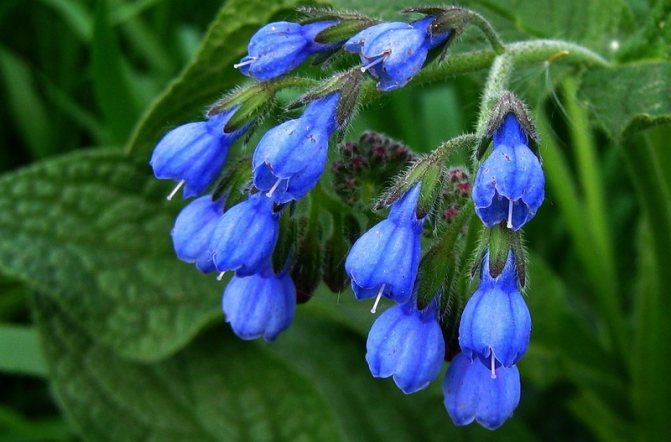

For this tool, you will need half a glass of fresh crushed roots, which must be filled with vodka 40 ° in an amount of 0.5 liters. Next, the mixture is placed in a dark cool place. After 10 days, the finished tincture should be filtered. The remedy is drunk in 20-30 drops. Dosing regimen - 3-5 times a day before meals, adding to a small amount of water.
With the help of the infusion and tincture of the comfrey plant, you can speed up the healing process in case of bone fractures, joint dislocations, severe bruises, osteomyelitis, as well as wounds and purulent periodontal disease.
Also, these funds are effective as baths, rinses, lotions, compresses, which can be combined with ingestion.
The drugs can alleviate the patient's condition with chronic inflammation, stomach and duodenal ulcers, diarrhea, dysentery, chronic bronchitis - they relieve inflammation, pain in the intestines.
The beneficial properties of the infusion from this medicinal plant are manifested in improving metabolism, digestion and increasing appetite.
Medicinal decoction of comfrey roots


To prepare this product, you will need 1 tablespoon of roots, which you need to fill with one glass of hot boiled water. Then the mixture is placed on the stove and boiled over low heat for 10 minutes. The finished broth must be filtered.
The tool is intended for internal and external use in the treatment of conditions such as:
Also, a decoction of comfrey root can help people who have uterine, hemorrhoidal and other bleeding, as well as signs of inflammation of the bladder.
It is useful to use a decoction of a medicinal plant to eliminate nosebleeds. This will require small swabs that are moistened in broth and then inserted into the nostrils.
Also, this remedy can treat skin wounds, abrasions, bruises with hemorrhage.
A decoction of the herb can also be used for cosmetic purposes. For this, lotions are made to eliminate the effect of dry skin, as well as poultices that are effective against irritation, redness and peeling of the skin.
With regular use of a decoction of the herb, you can improve the condition of hair that has a problem such as alopecia areata - hair loss.
In conclusion about comfrey grass
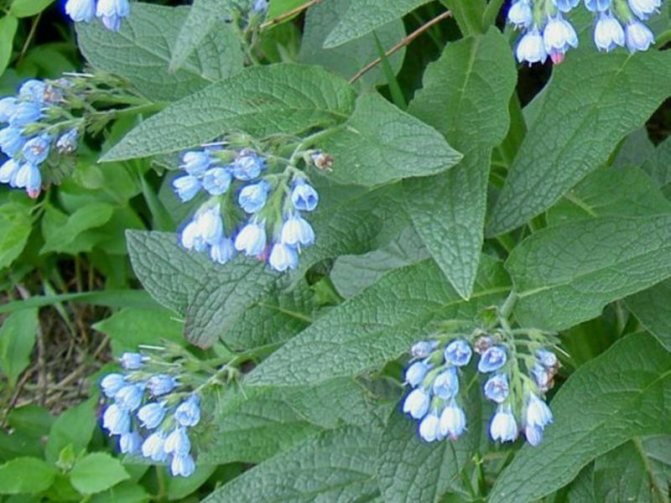

Comfrey is a fairly well-known plant in our country that is often used as an effective remedy in the treatment of fractures. Moreover, the most valuable part of the comfrey is the roots, from which the preparations are prepared.
The healing properties of comfrey are associated with its ability to act on damaged tissues, triggering the mechanism of their regeneration. Therefore, it is appropriate to use this remedy not only for minor injuries, such as wounds and abrasions, but also for more serious conditions, such as fractures.
On the basis of the roots and leaves of medicinal comfrey, infusions, tinctures and decoctions are prepared, which can help with other painful conditions. Therefore, with inflammatory processes occurring in the internal organs, as well as weakened immunity, many experts advise using drugs based on this plant.
Video: Useful properties of Comfrey
Contraindications for larkspur
Due to the danger of using larkspur in some cases, taking drugs based on it has many contraindications. So, it is prohibited for use:
- pregnant women;
- hypotension;
- with a decrease in the general tone of the body and a decline in strength;
- with myasthenia gravis and muscle hypotonia;
- in case of poisoning;
- with convulsions;
- with weakness of the heart system.
Allowed during pregnancy use the product only externally - in the form of ointments and balms - for pain in the back, knees and joints, tension in the spine associated with changes in the body when carrying a child.
Children should be given preparations from this herb with great care, especially if they are under 12 years old. Self-medication can lead to serious consequences, therefore, if possible, the use of drugs based on larkspur in children is better to limit or replace the therapeutic agent with another.
Overdose is extremely dangerous - it leads to severe poisoning and seizures. The plant is very toxic, its poison harms not only people, but also animals - up to death. In case of poisoning with a spur, it is necessary to wash the stomach and take adsorbents.
Short description
Comfrey is a genus of forest herbaceous perennials belonging to the Borage family. The plant is ubiquitous in Europe from the United Kingdom to western Asia. Other names of culture are often found in the literature:
- vis-grass;
- larkspur;
- the grass is a bone breaker;
- bone crusher-joint grass;
- greasy root.
The stems of the plant are straightened and thickened, with spreading branches covered with fine hairs. The root system is voluminous, the roots are branched and thick, many processes are located on them. The roots are black on top, but inside they have a white color, greasy and juicy to the touch. The foliage is large, ovoid. The tip of the leaves is pointed. The lower leaves are attached to the stem with petioles, while the upper ones are sessile. Above, the leaves are covered with rough dense hairs.
The flowers are bell-shaped, arranged in racemose inflorescences on the top of the stems. In the first stages, the flowers are painted purple, red or lilac, gradually changing color to cream or blue. Flowering begins in May and usually lasts until July.
Attention! Fruits - four smooth and shiny nuts with one seed, ripen from July to September.
The plant does not have any soil preference and can grow in various types of soil.The culture under natural conditions propagates by seeds (including self-sowing), and in the cultural environment, propagation by rhizome segments is usually used.
Medicinal properties
Comfrey is characterized by a rich chemical composition. At the same time, one of the most important components of the plant is allantoin, a natural antibiotic with a powerful anti-inflammatory and bactericidal effect. This compound relieves inflammation and promotes the formation of new cells, which allows for quick and effective treatment.
Because of this, comfrey has the following health benefits:
- anti-inflammatory;
- healing;
- antirheumatic.
The use of comfrey is widespread in the fight against severe bruises, fractures, dislocations, joint diseases, it relieves swelling and inflammation. Separately, it should be noted assistance in the healing of injured cartilage when using the plant. In addition, culture-based folk remedies should be used for the following diseases and problems with the body:
- bone tuberculosis, ostiomyelitis;
- periodontal disease, stomatitis;
- flu, pneumonia, colds, bronchitis, throat ailments;
- skin diseases, burns;
- ulcers of the gastrointestinal tract;
- neuralgia;
- hemorrhoids;
- fractures, sprains;
- arthritis, arthrosis, gout;
- external and internal bleeding, thrombophlebitis;
- soft tissue bruises, wounds with pus;
- mastopathy;
- cancer of the lungs, mammary glands, prostate, etc.
Important! Before using comfrey preparations, it is imperative to consult a qualified specialist.
The plant has certain contraindications. So, the use of bone crusher grass and its treatment is limited or prohibited in the following cases:
- period of gestation and breastfeeding;
- the patient's age up to 18 years;
- allergy, individual intolerance;
- liver disease.
The duration of the treatment course should not exceed one and a half months per year when using alcohol tincture, ointment or gel. In addition to these dosage forms, infusions and decoctions for internal use are prepared from comfrey according to special recipes.
Harvesting and storage
It is necessary to collect comfrey roots in early spring, when flowers and stems have not yet begun to form. This should be done in a short time, since the healing properties of plant materials are gradually decreasing. The next period of harvesting the roots begins in the fall, when the seeds fall off.
The plant is dug out of the ground and the lateral young roots are broken off from it, which are easily separated. The rest of the bush is planted back in the ground, where it will soon take root. The roots are thoroughly washed and cut in two. They are placed in the sun, under the wind, for drying, and then moved to a dry, darkened room for final drying.
Additional Information: during drying, the temperature should not exceed + 60 ° C, so as not to violate the healing properties of the roots.
The roots are stored in cardboard boxes, cloth bags or tightly covered containers. The container should be located in rooms with low air humidity. If all the necessary storage conditions have been provided, dried raw materials will retain their useful properties for three years.
If all the requirements for cultivation are met, you can get high-quality plantings of comfrey. They can then be used to make healthy folk remedies.
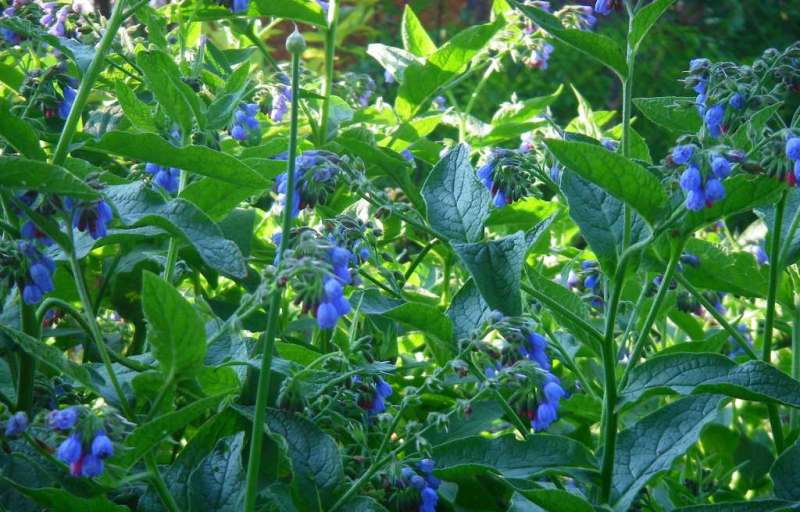

Where does the comfrey grass grow, what it looks like and what are its medicinal properties - let's look from the description below, look at its appearance from the photo and get additional information about the medicinal herb from the video.
Comfrey is the official name of the plant, which many know as the larkspur.
People were able to evaluate its useful properties during the war and epidemic, since it can be used to effectively treat severe fractures and wounds.Therefore, every field doctor must have a comfrey with him. The healing effect of this plant is associated with its effects on bones and joints. With its timely application, damaged tissues begin to recover quickly, therefore it is often used for fractures, dislocations of joints and bruises. In other words, this plant is ideal for situations where it is necessary to disinfect the wound and speed up the process of tissue regeneration.

